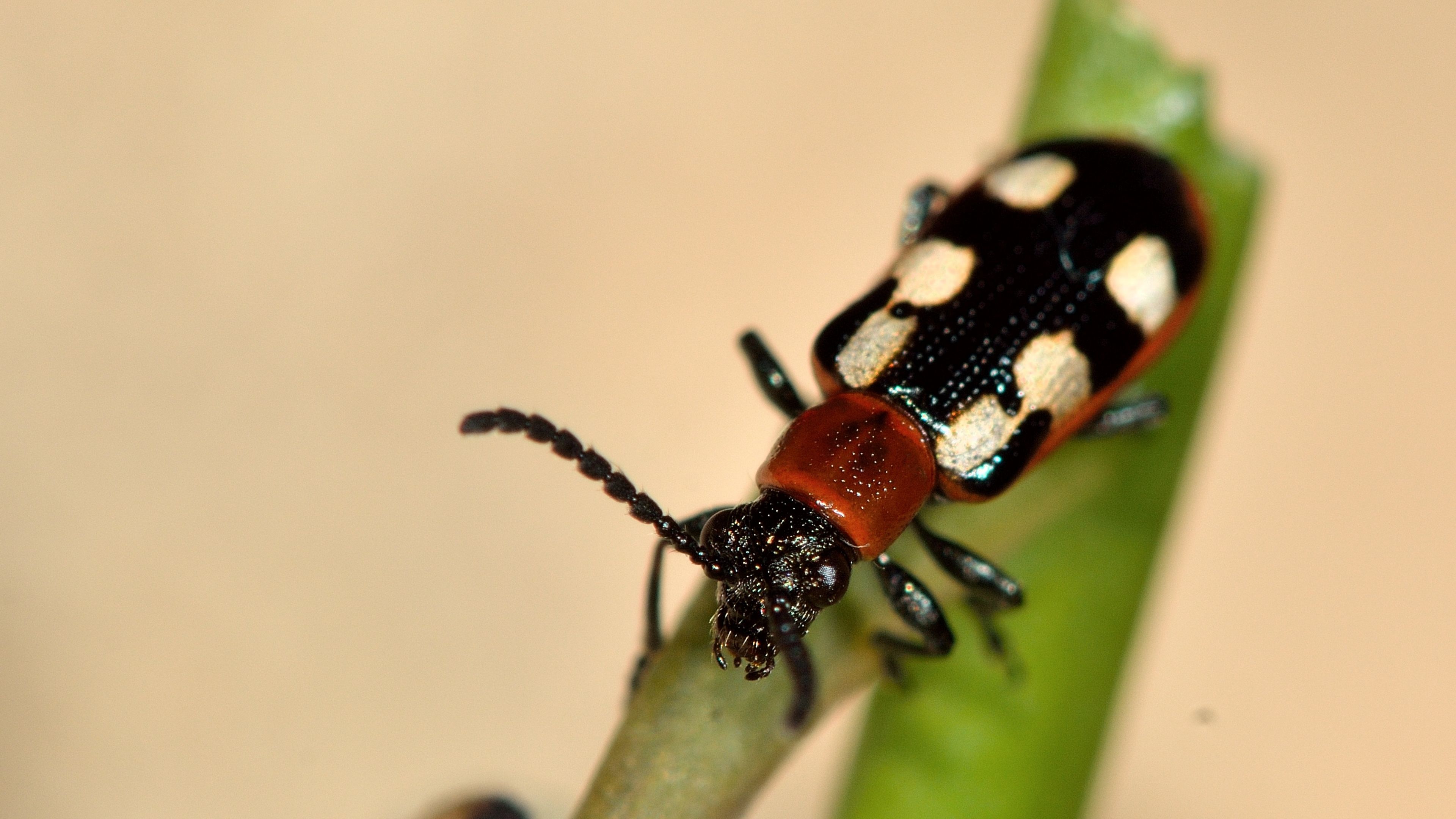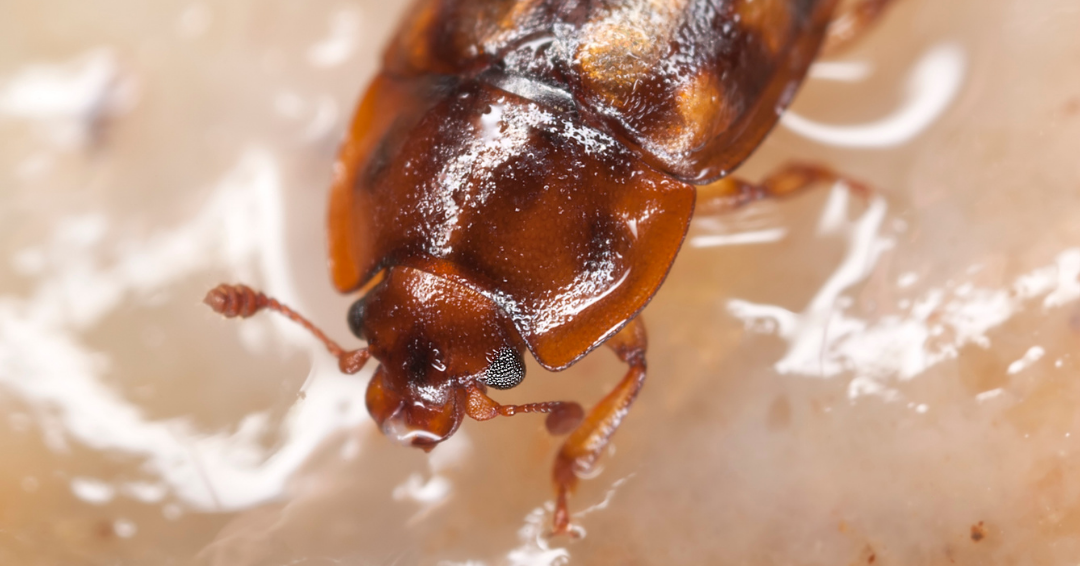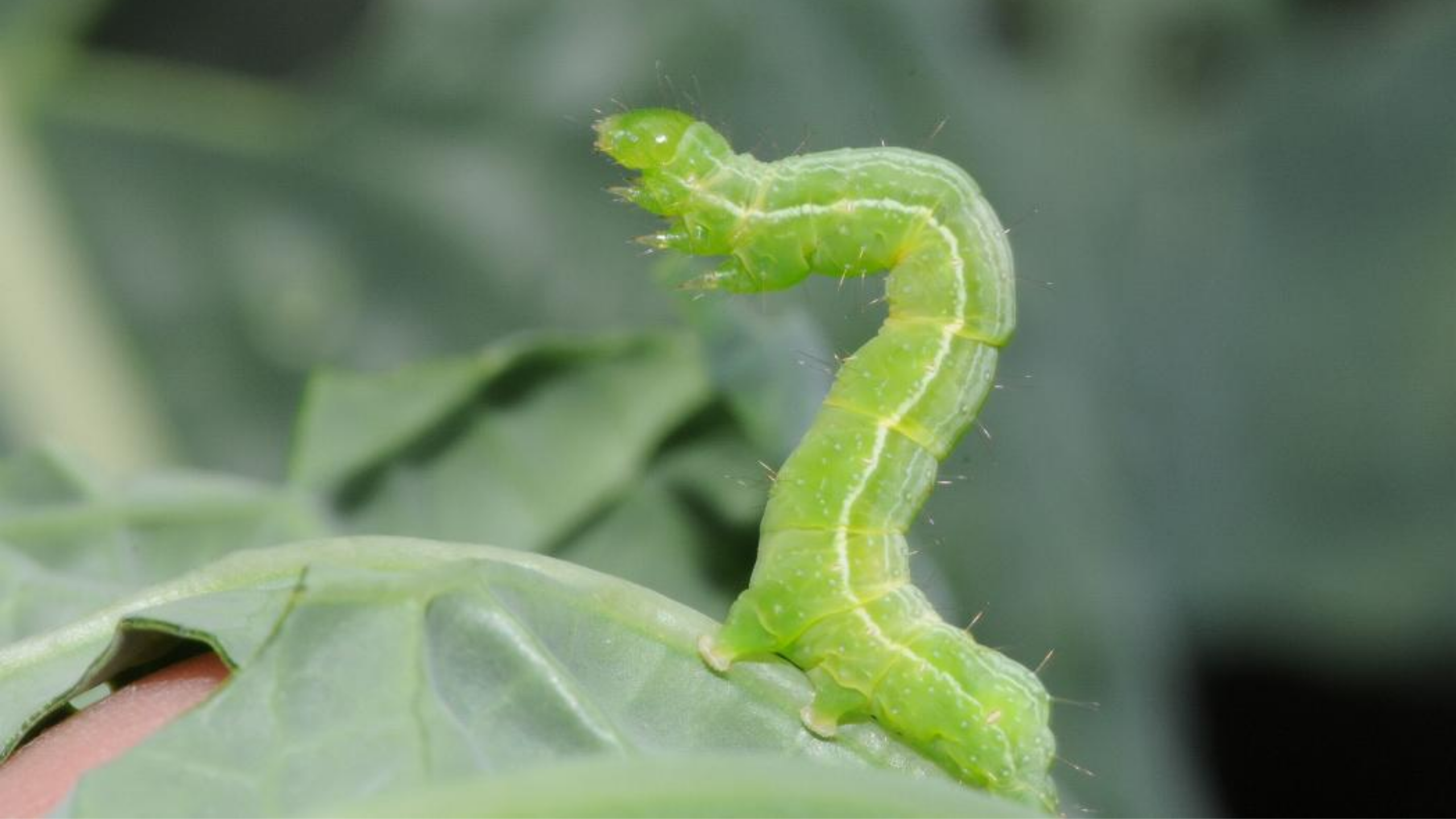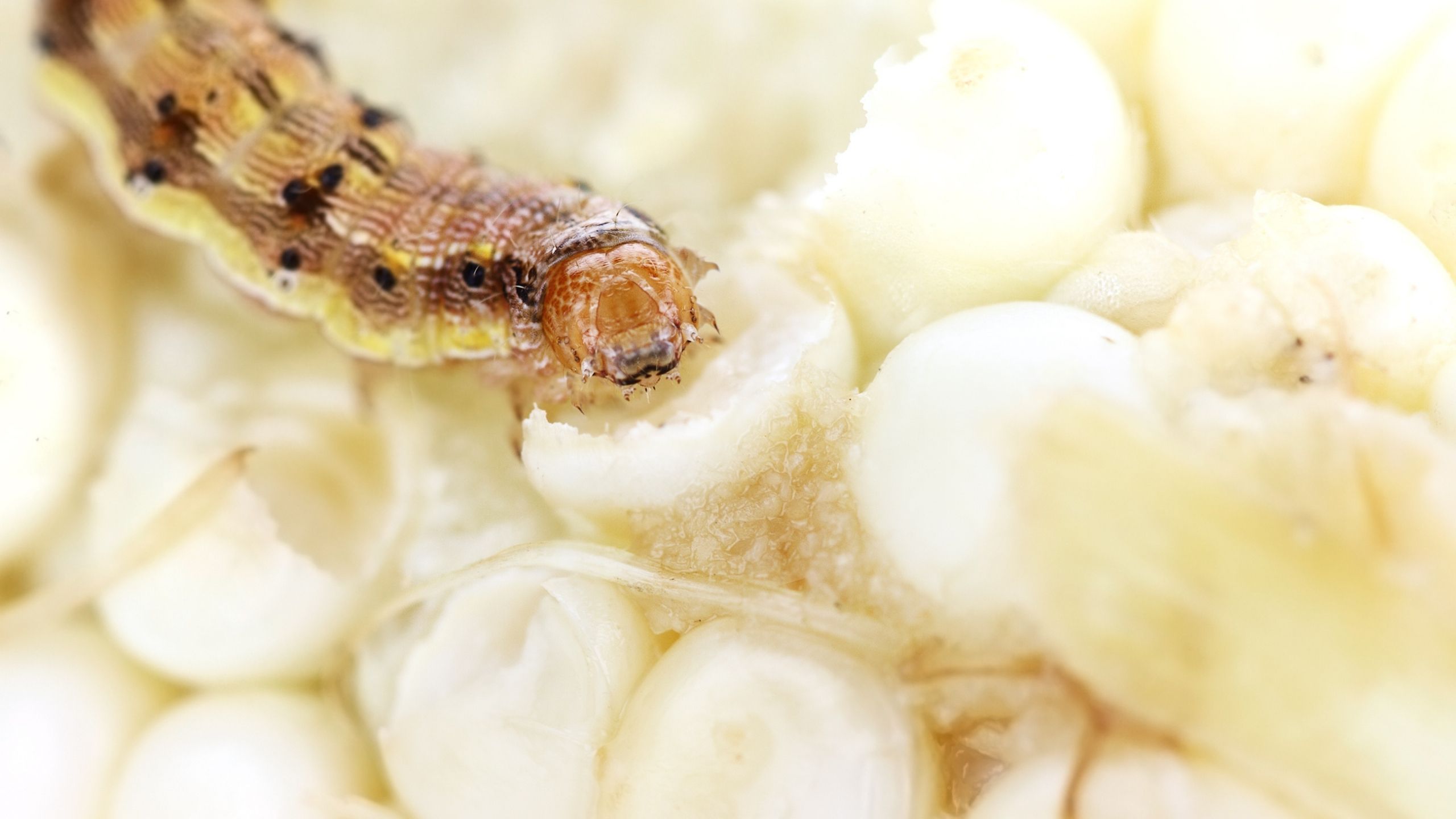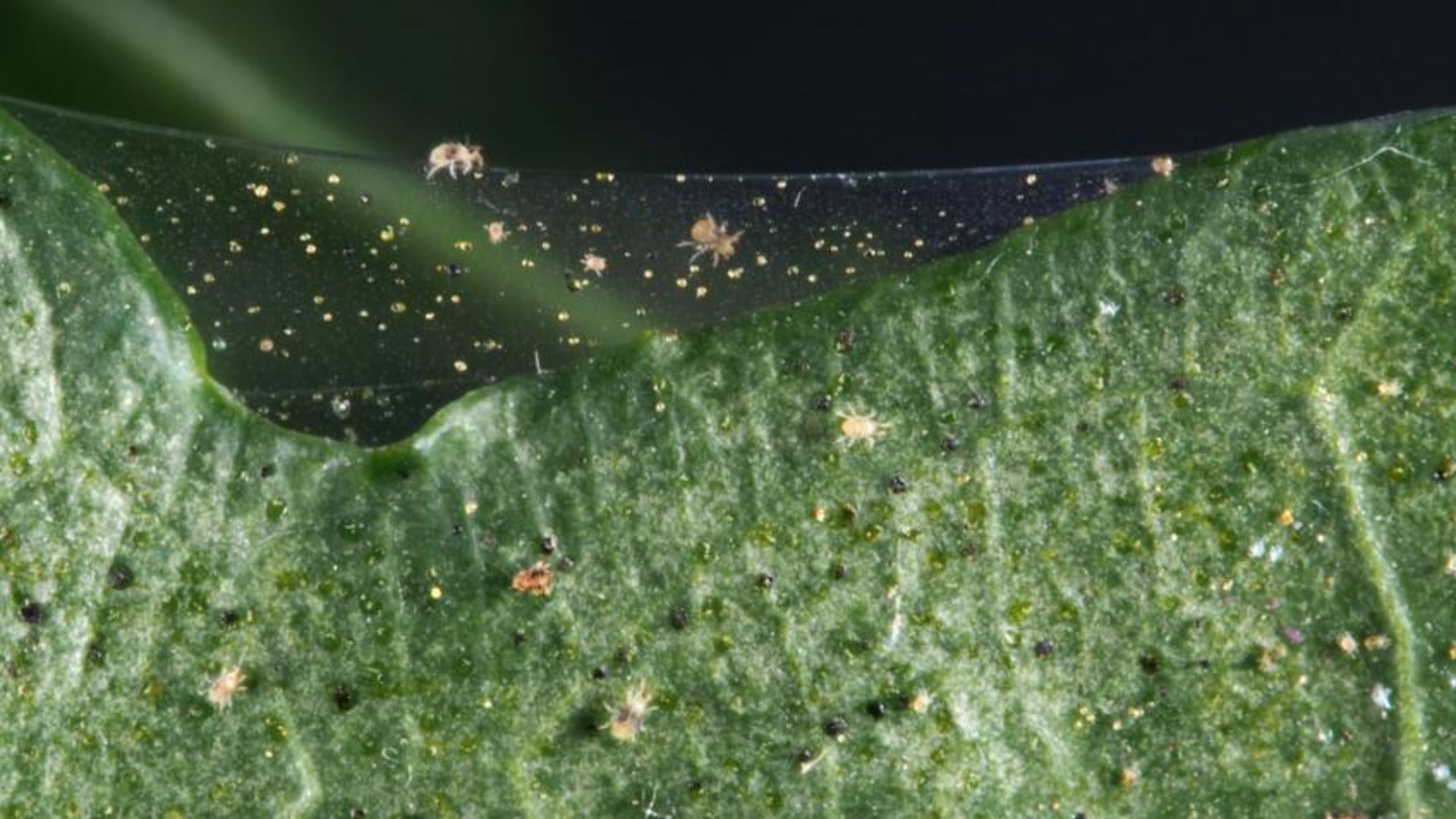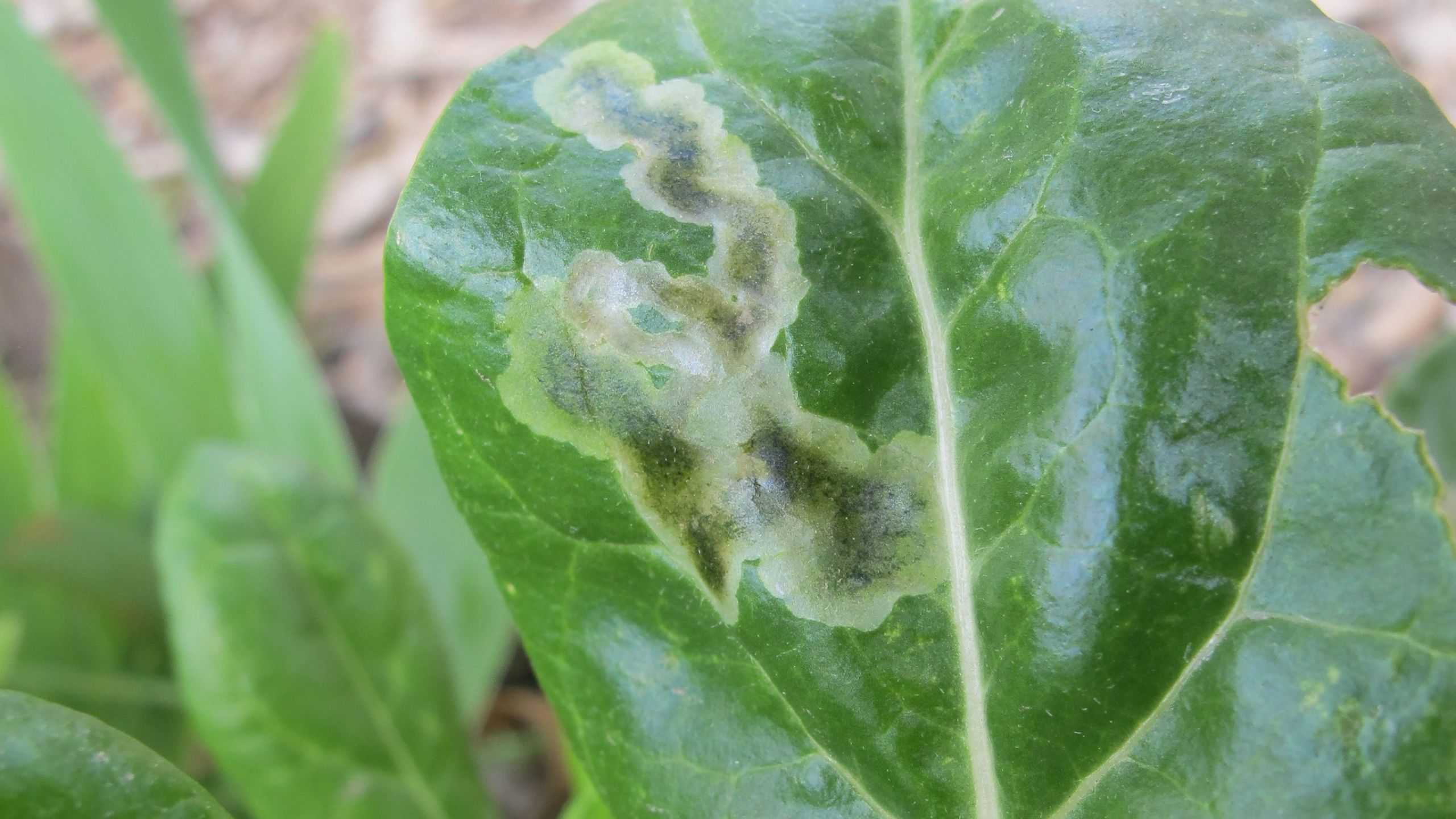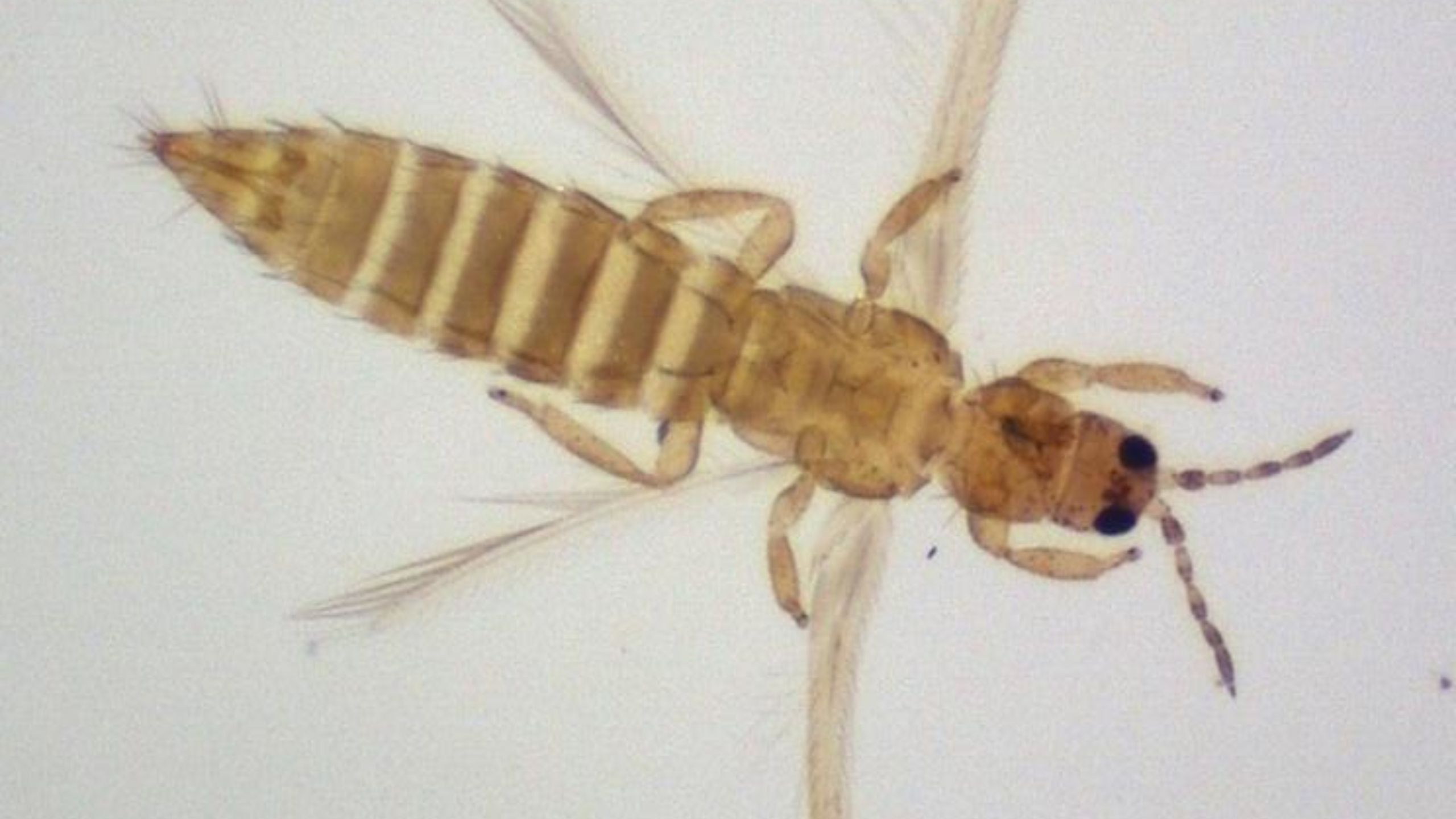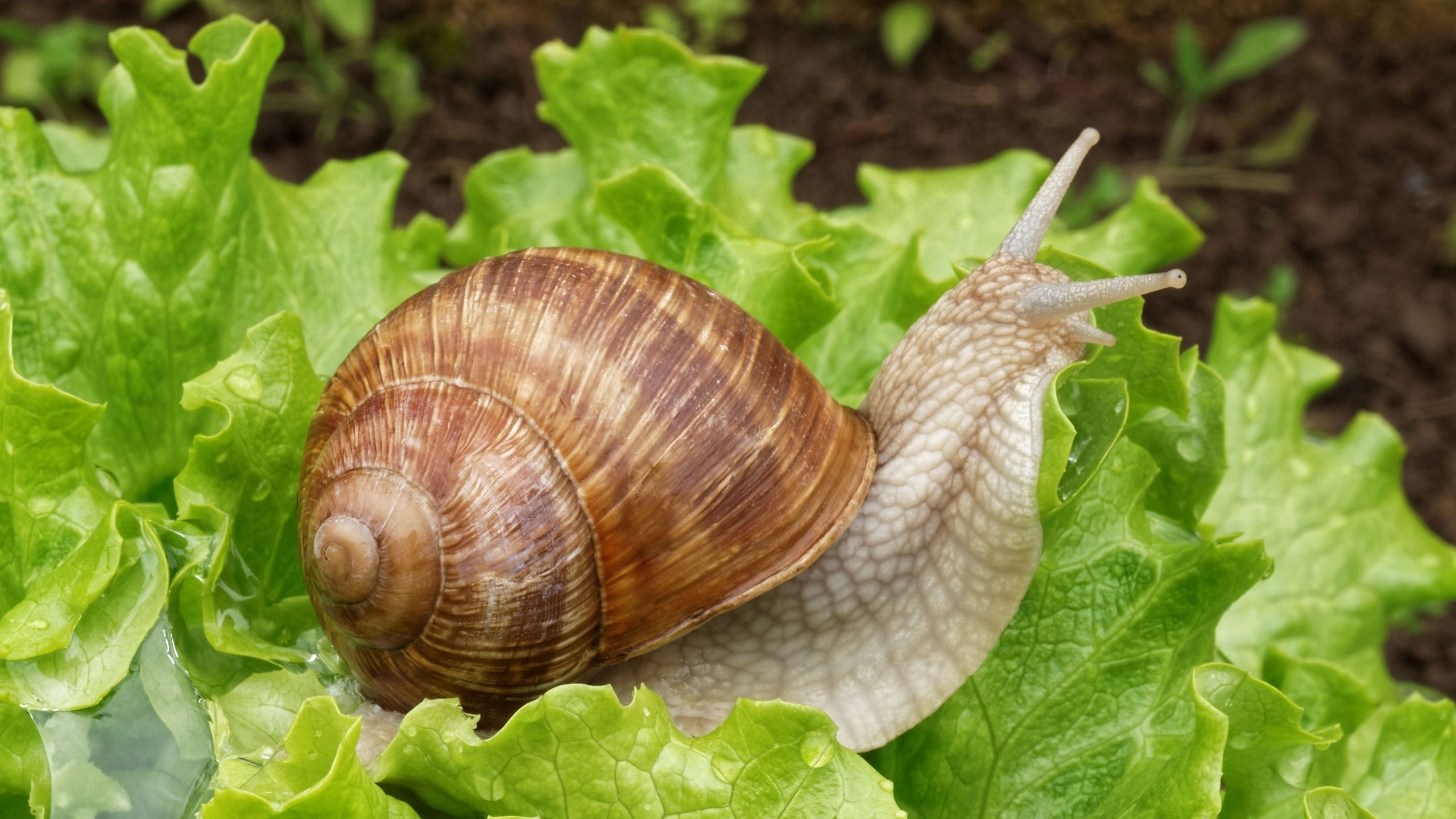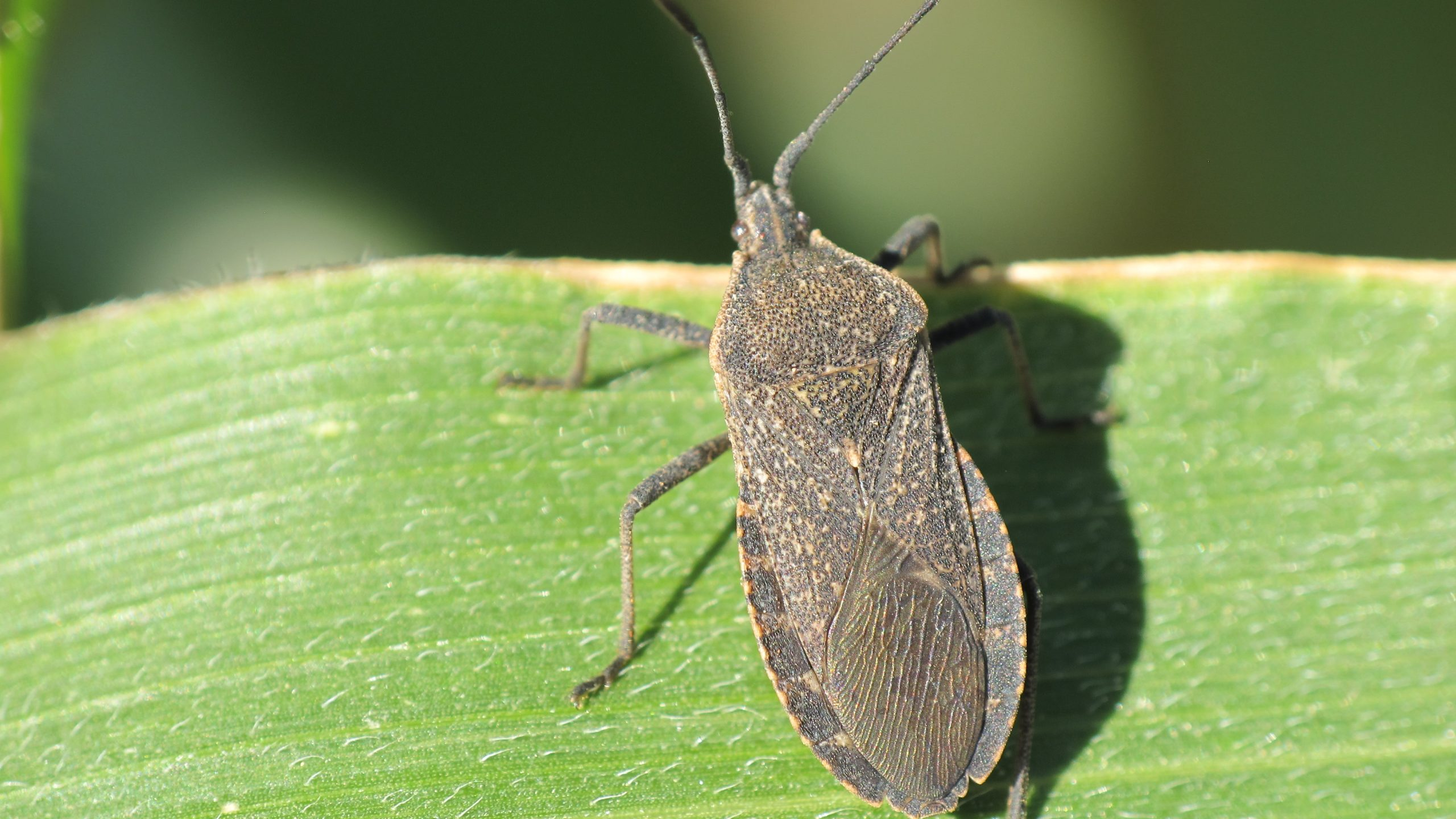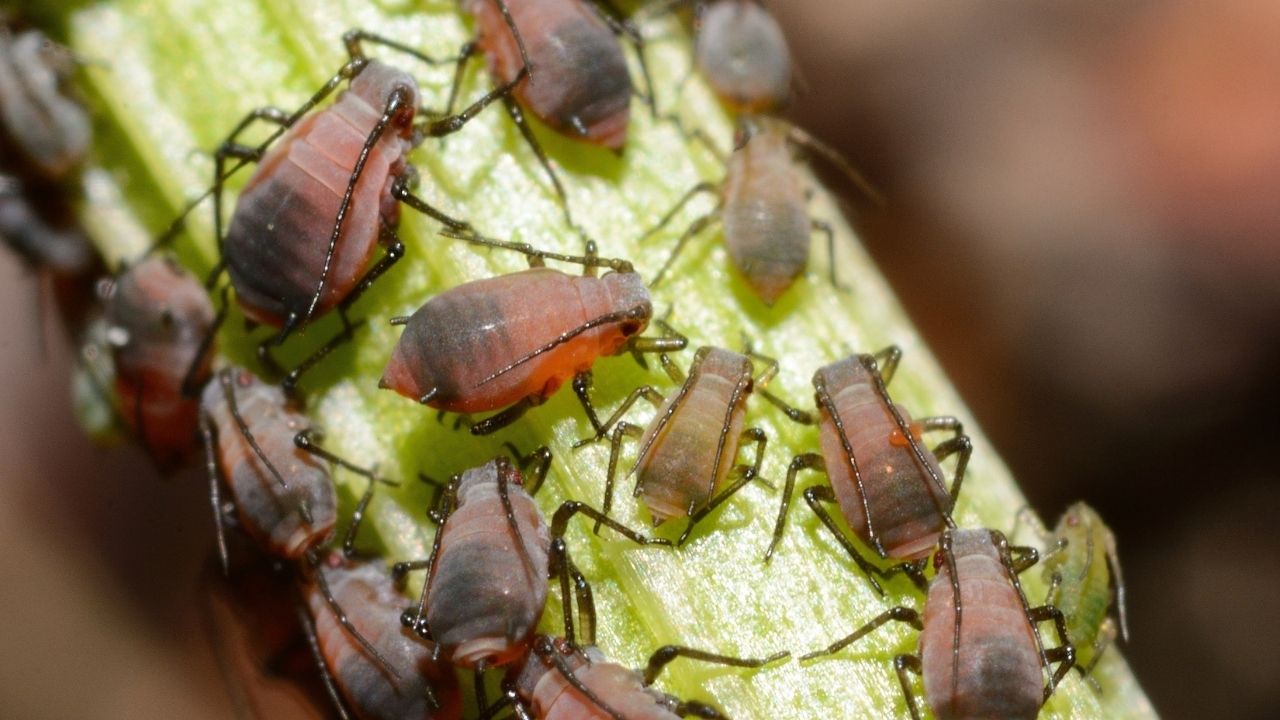European Earwig
(Forficula auricularia)
August 2011
Diane Alston, Extension Entomologist (No longer at USU) • Andrew Terbeau, USU Biology

Fig. 1. European earwig adult and nymphs.
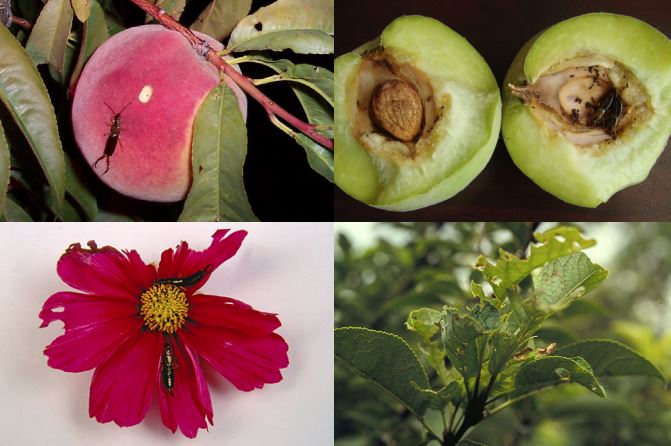
Fig. 2. Clockwise from top left: injury to peach fruit, earwigs inside split pit of peach fruit, injury to new growth of ornamental tree, and injury to a flower. Image courtesy of the Royal Horticultural Society (last image only).
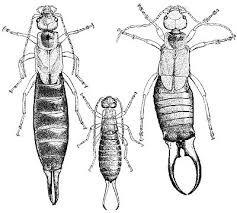
Fig. 3. Female, third instar nymph, and male adult European earwig (male has strongly curved cerci). Image courtesy of Louise Kulzer, Bug of the Month, October 1996, http://crawford.tardigrade.net/bugs/BugofMonth24.html.
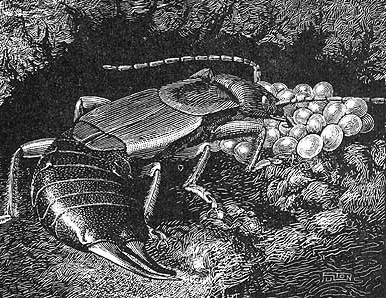
Fig. 4. Female brooding her eggs in a nest. Image courtesy of Louise Kulzer, Bug of the Month, October 1996, http://crawford.tardigrade.net/bugs/BugofMonth24.html.

Fig. 5. A roll of corrugated cardboard tied to a tree trunk can attract earwigs during daytime.

Fig. 6. Traps with smelly fish and seafood oils or bacons grease can be effective in attracting and killing earwigs.
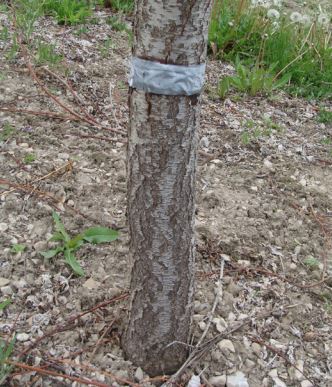
Fig. 7. A sticky trunk band can exclude earwigs.
Quick Facts
- The European earwig is an omnivore; it feeds on detritus, fungi, plants, and insects.
- Earwigs can injure the buds, leaves, flowers, and fruits of a broad range of plants, including fruits, vegetables, and ornamentals; they can be a nuisance pest by entering buildings.
- Earwigs are active at night and seek protected shelter during the daytime.
- Optimal management is a balance of protecting plants from injury while reaping benefits from biological control and organic matter decomposition.
The European earwig (Order Dermaptera, which means “skin wings” to describe their leathery wings) (Fig. 1) is native to Europe, western Asia, and parts of Africa. The common name “earwig” comes from a myth that the insect would climb into the ears of humans and chew into the brain, but this is false. The European earwig was first introduced into Utah in the early 1900s. Establishment,and population growth have been remarkably successful in northern Utah. It has become an insect of concern and interest because of its abundance and omnivorous feeding behaviors that make it both a pest and beneficial insect.
Damage
The diverse diet of earwigs includes primitive plants (mosses, lichens, and algae), vascular plants, fungal spores, small invertebrate animals, and decaying organic matter. As opportunistic predators, they provide a benefit by preying upon plant pests such as aphids, scales, caterpillars, maggots, and mites. In contrast, their herbivorous eating behavior makes them a common pest in agricultural crops, home gardens, and landscapes; they often require intervention to reduce their damage to plants. They can also be a nuisance when they seek shelter in homes and workplace buildings.
The European earwig can feed upon and damage a broad range of agricultural products that may include tree fruits, berries, vegetable fruits, leafy vegetables and herbs, grasses, grains, and ornamentals. They prefer ripe fruits over firm, premature fruits. Earwigs feed on, the buds, flowers, fruits, and leaves causing direct plant damage, reduced crop yields, and aesthetic injury (Fig. 2). They will occasionally damage a variety of stored food products.
Life History
Two biotypes of the European earwig occur in the U.S. which differ by location (western vs. eastern states), life history, and European origin. In the western U.S., the European earwig has two or more generations per year, and populations tend to build to their highest densities in mid to late summer.
Adult - Overwintering, Dispersal, and Damaging Stage
- Elongate brown body with a red-brown head; 1/2 to 5/8 inch long.
- A prominent pair of “pinchers” (cerci) on the rear of the body; female cerci are straight while those of males are strongly curved (Fig. 3) for grasping females during mating.
- Hide in dark, tight, and moist places during the daytime; pheromones from frass (feces) and cuticular hydrocarbons (exoskeleton chemicals) attract earwigs to congregate.
- May seek shelter inside buildings.
- In the western U.S., adults overwinter in the soil as brooding pairs or above ground in aggregations.
- Females lay a clutch of eggs in the spring; they may lay more than one clutch if resources are sufficient.
Egg
- About the size of a pinhead (1 mm diameter), elliptical, and pearly white; darken and increase in size as the eggs near hatching.
- Laid in clusters of 30-50 within nests in the soil.
- Mothers defend their nests and remove mold and other hazards (Fig. 4).
- Hatch in about 170 degree-days (DD>47°F) or beginning in mid May in northern Utah (see Table 1).
Nymph - Damaging and Dispersal Stage
- Four nymphal instars (immature stage with a molt of the outer cuticle between each instar); gray to light brown in color and similar in appearance to adults; 4 to 11 mm (approx. 1/4 to 1/2 inch) long.
- First and some second instar nymphs remain in the nest where the mother protects them.
- Second through fourth instars disperse from the nest in search of food.
Management
Monitoring and Trapping
A simple corrugated cardboard trap is an effective monitoring tool (Fig. 5). Earwigs are active at night and seek refuge in the cardboard traps during daytime. Rolls or sheets of cardboard or newspaper can be used for mass trapping to reduce earwig densities. Collect the traps into plastic bags and dispose every 2-3 days during the summer. Studies at Colorado State University found that adding food bait, such as wheat bran or wheat germ, to traps made them more attractive. Earwigs are also attracted to containers with smelly oils, such as fish or clam oil, or bacon grease. Punch holes in the lid and top sides of a plastic yogurt or sour cream container, and bury the bottom in a garden or flower bed where earwigs are causing plant damage (Fig. 6). Check the traps several times per week, dispose of the earwigs, and replenish with fresh bait.
Exclusion
Earwigs are weak fliers, and primarily disperse by crawling. Place a band of sticky adhesive, such as tangletrap*, around a tree trunk or plant stem to exclude them. Apply the adhesive to a surface such as duct tape to protect the plant (Fig. 7).
Prevent their entry into buildings by sealing cracks and crevices, installing under-door-sweeps, and ensuring that screens are tightly sealed. Remove vegetation and sheltering debris (including mulches) adjacent to buildings in areas where earwigs are likely to gain access, such as doorways and basement window wells. Apply insecticides as a barrier treatment around foundations.
*There are many online sources of tangletrap (conduct an Internet search), and some garden suppliers in Utah may carry the product.
Biological Control
There are few predators of earwigs. They emit a foul smelling chemical that is distasteful to many predators; however, birds have been observed feeding on earwigs in cardboard traps. Several species of parasitic tachinid flies (Diptera: Tachinidae) were released into
the northwestern U.S. and Europe in 1924 to 1930 to attack and suppress the European earwig. In Utah, one species of tachinid was released by George F. Knowlton, Utah State University Entomologist, in Farmington (Davis County) in 1939. A few tachinids have been recovered from European earwigs in recent years. It is noteworthy that the parasitoid has persisted in Utah for over 60 years; however, parasitism levels are low and suppression of European earwig populations is inadequate.
Phenology Model
A phenology or degree-day model can provide prediction of when insect life stages will be active, when crop injury may occur, and optimal timing for insect control. Research is underway to validate and modify a degree-day model developed in northern Europe. Preliminary results for timing of earwig life stages in peach orchards in northern Utah are provided in Table 1.
| Degree-Days | Earwig Life Stage Event | Date in 2010 |
|---|---|---|
| 170 DD | Egg Hatch Begins | Mid May |
| 300 DD | 2nd Instar Nymphs | June 10 |
| 360 DD | 3rd Instar Nymphs | June 17 |
| 500 DD | 4th Instar Nymphs | June 29 |
| 725 DD | Summer Generation Adults | July 17 |
Chemical Control
Insecticides that are effective in reducing European earwigs, and registered in Utah as of 2011, include (grouped by class, i.e., mode of action) the following list. Read the product label carefully to determine in which sites (crops, ornamentals, or structures) the product can be applied. Only apply insecticides when deemed necessary to conserve beneficial insects and mites.
Botanical and Mineral: diatomaceous earthOH, pyrethrin (Pyganic)OH
Carbamate: carbaryl (Sevin)H
Insect Growth Regulator: azadirachtin (Azatin, Neemix)OH, novaluron (Rimon), pyriproxyfen (Esteem)
Microbial: spinosad (Success, EntrustO)H, spinetoram (Radiant)
Organophosphates: diazinon (Diazinon), malathion (Malathion)H
Synthetic Pyrethroids: bifenthrin (Bifen, Brigade, Talstar, others)H, cyfluthrin (Baythroid, Tempo, others)H, cypermethrin (Cynoff, Cyper, Demon, others)H, deltamethrin (Delta, Suspend, others)H, lambda-cyhaolothrin (Cyonara, Demand, Karate, others)H, permethrin (Ace, Bonide, others)H
OOrganic (OMRI-approved) products available.
HHomeowner products available.
All brands are registered trademarks. Examples of brands may not be all-inclusive, but are meant to provide examples of products registered in Utah. The availability of insecticides changes rapidly. Always read the label for registered uses, application and safety
information, and protection and pre-harvest intervals.
References and Further Reading
- Cranshaw, W. S. 2010. European earwigs. Colorado State University Extension Publication No. 5.533,
- Crumb, S. E., P. M. Eide, and A. E. Bonn. 1941. The European Earwig. USDA Technical Bulletin, Bureau of Entomology and Plant Quarantine, No. 766.
- Jacobs, S. 2009. European earwigs. Pennsylvania State University Entomological Notes NP-4,
- Knowlton, G. F. 1940. The European earwig in Utah. Journal of Economic Entomology 33: 204.
- Moerkens, R., B. Gobin, G. Peusens, H. Helsen,R. Hilton, H. Dib, D. M. Suckling, and H. Leirs. 2011. Optimizing biocontrol using phenological day degree models: the European earwig in pipfruit orchards. Agricultural and Forest Entomology
Related Research


